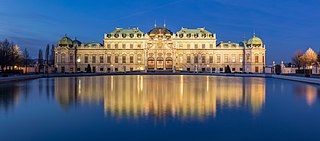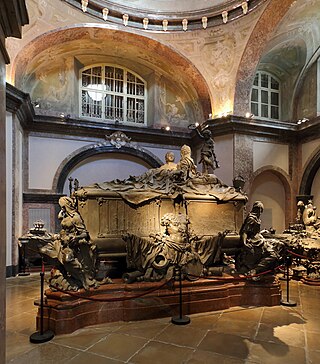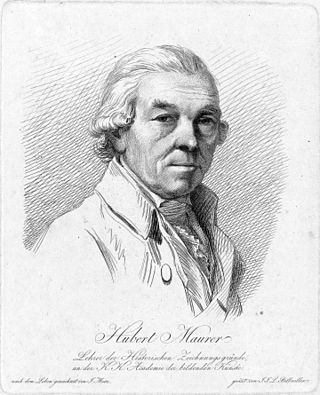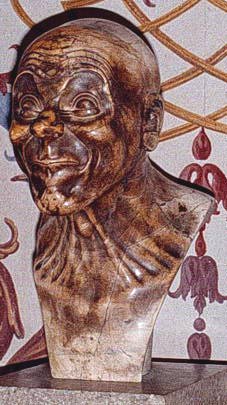
Franz Xaver Messerschmidt was a German-Austrian sculptor most famous for his "character heads", a collection of busts with faces contorted in extreme facial expressions.

The Vatican Museums are the public museums of Vatican City. They display works from the immense collection amassed by the Catholic Church and the papacy throughout the centuries, including several of the most well-known Roman sculptures and most important masterpieces of Renaissance art in the world. The museums contain roughly 70,000 works, of which 20,000 are on display, and currently employs 640 people who work in 40 different administrative, scholarly, and restoration departments.

The Belvedere is a historic building complex in Vienna, Austria, consisting of two Baroque palaces, the Orangery, and the Palace Stables. The buildings are set in a Baroque park landscape in the third district of the city, on the south-eastern edge of its centre. It houses the Belvedere museum. The grounds are set on a gentle gradient and include decorative tiered fountains and cascades, Baroque sculptures, and majestic wrought iron gates. The Baroque palace complex was built as a summer residence for Prince Eugene of Savoy.
Franz Xaver Kroetz is a German author, playwright, actor and film director. He achieved great success beginning in the early 1970s. Persistent, Farmyard, and Request Concert, all written in 1971, are some of the works conventionally associated with Kroetz.

Franz Xaver Wolfgang Mozart, also known as Wolfgang Amadeus Mozart, Jr., was the youngest child of six born to Wolfgang Amadeus Mozart and his wife Constanze and the younger of his parents' two surviving children. He was a composer, pianist, conductor, and teacher of the late classical period whose musical style was of an early Romanticism, heavily influenced by his father's mature style. He knew Franz Schubert and Robert Schumann, both of whom held him in high esteem.
Messerschmidt or Messerschmitt is an occupational surname of German origin, which means cutler or knifemaker, from the Middle High German words mezzer "knife" + smit "smith". It may refer to:

The Academy of Fine Arts Vienna is a public art school in Vienna, Austria.

A bust is a sculpted or cast representation of the upper part of the human body, depicting a person's head and neck, and a variable portion of the chest and shoulders. The piece is normally supported by a plinth. The bust is generally a portrait intended to record the appearance of an individual, but may sometimes represent a type. They may be of any medium used for sculpture, such as marble, bronze, terracotta, plaster, wax or wood.

The Apollo Belvedere is a celebrated marble sculpture from classical antiquity.

Balthasar Ferdinand Moll was one of the most famous sculptors in Vienna during the height of the Baroque era

The Neue Pinakothek is an art museum in Munich, Germany. Its focus is European Art of the 18th and 19th centuries, and it is one of the most important museums of art of the nineteenth century in the world.

Joseph, Baron Ducreux was a French noble, portrait painter, pastelist, miniaturist, and engraver, who was a successful portraitist at the court of Louis XVI of France, and resumed his career at the conclusion of the French Revolution. He was made a baron and premier peintre de la reine, and drew the last portrait ever made of Louis XVI before the king's execution. His less formal portraits reflect his fascination with physiognomy and show an interest in expanding the range of facial expressions beyond those of conventional portraiture.
A simpleton is a stock character in folklore who lacks common sense.

Wiesensteig is a town in the district of Göppingen in Baden-Württemberg in southern Germany. It is located on the river Fils, 16 km south of Göppingen.

Lorenzo Mattielli was an Italian sculptor from the Late Baroque period. His name has also variously been written as Matielli, Mattiely, Matthielli, and Mathielli. He supplied statuary for palaces and churches in Vienna and Dresden and for the monastery of Melk (Austria).
Events from the year 1736 in art.

A tronie is a type of work common in Dutch Golden Age painting and Flemish Baroque painting that depicts an exaggerated or characteristic facial expression. These works were not intended as portraits or caricatures but as studies of expression, type, physiognomy or an interesting character such as an old man or woman, a young woman, the soldier, the shepherdess, the "Oriental", or a person of a particular race.

Hubert Maurer was a German painter, graphic artist and art professor.
Tony Bevan is a British painter, known for his psychologically charged images of people at the edge of respectable society.

Johann Nepomuk Schaller was an Austrian sculptor. His most famous work is a bust of Ludwig van Beethoven at age 55, created at the request of the composer's secretary Karl Holz in 1825. It was later presented to the Royal Philharmonic Society, London, on the occasion of the Beethoven Centennial.















